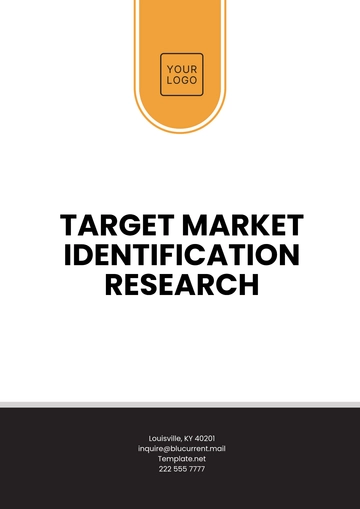Free Sample Market Entry Research

Company: [Your Company Name]
Researcher: [Your Name]
I. Executive Summary
As business consultants, our mission for 2052 is to assess the viability of entering new markets. This report covers market overview, customer analysis, competitive landscape, regulatory environment, SWOT analysis, market entry strategies, marketing strategies, and financial projections, offering comprehensive insights for informed decision-making.
II. Market Overview
The global market landscape in 2052 is highly dynamic, influenced by advancements in technology, changes in consumer behavior, and evolving regulatory environments. With significant growth in emerging economies and a focus on sustainable development, businesses must adapt to the demands of a globalized and environmentally conscious consumer base.
III. Customer Analysis
Segment | Characteristics | Needs | Preferences |
|---|---|---|---|
Millennials and Gen Z | Tech-savvy, social media driven, value experiences over material goods | Convenience, innovation, environmental sustainability | Eco-friendly products, digital integration, seamless experiences |
Gen X and Baby Boomers | Brand loyal, value quality and reliability | Quality, trust, proven track record | Classic designs, high-quality customer service, reliability |
IV. Competitive Analysis
The competitive landscape in 2052 is characterized by entrenched players with innovation and strong brand loyalty being key differentiators. Notable competitors operating in this space include:
Company A: Market leader in providing innovative eco-friendly products.
Company B: Renowned for innovative tech and customer focus.
Company C: Leads with affordable solutions and vast distribution networks.
V. Regulatory and Legal Environment
Region | Compliance Requirements | Impact on Market Entry |
|---|---|---|
North America | Strict adherence to ESG guidelines, rigorous data security measures | Significant initial investment but long-term market stability |
Europe | Compliance with GDPR, commitment to sustainable practices | Opportunities for companies with high standards of data protection and sustainability initiatives |
Asia Pacific | Adaptation to local laws, investment in digital infrastructure | High growth potential with tailored legal strategies |
VI. SWOT Analysis
Strengths | Weaknesses | Opportunities | Threats |
|---|---|---|---|
Innovative technology, strong brand recognition | High initial cost, complex regulatory compliance | Emerging markets, increasing demand for sustainable products | Intense competition, regulatory changes |
VII. Market Entry Strategies
Strategy | Advantages | Disadvantages |
|---|---|---|
Joint Ventures | Shared risk, local market knowledge | Limited control, profit sharing |
Direct Investment | Full control, higher profit potential | High-risk, significant capital requirement |
Franchising | Rapid market penetration, lower capital investment | Quality control issues, lower revenue per unit |
VIII. Marketing Strategies
To ensure successful market entry, the following marketing strategies are recommended:
Digital Marketing: Leverage social media, SEO, and PPC to reach tech-savvy consumers.
Content Marketing: Create engaging and informative content to build brand authority.
Partnerships and Influencers: Collaborate with local influencers and businesses to build trust and authenticity.
Localized Advertising: Customize advertising campaigns to align with local cultural nuances and consumer preferences.
IX. Financial Projections
Year | Investment | Revenue | Profit Margin |
|---|---|---|---|
2052 | $10 million | $12 million | 20% |
2053 | $8 million | $15 million | 30% |
2054 | $5 million | $18 million | 35% |
Chart I: Projections for the Company
Over the years 2052 to 2054, investment decreased from $10 million to $5 million, while revenue increased from $12 million to $18 million. Profit margin improved from 20% to 35%, reflecting greater efficiency and profitability.
X. Conclusion and Recommendations
Findings | Recommendations | Rationale |
|---|---|---|
High market potential in emerging economies | Invest in joint ventures in the Asia Pacific | Shared risk and local knowledge can boost market penetration |
High regulatory compliance in North America and Europe | Strengthen ESG and data privacy measures | Enhances trust and legality, ensuring long-term success |
Intense competition from established players | Diversify through innovation and strategic partnerships | Remain competitive by offering unique value propositions |
In summary, market entry in 2052 requires a detailed understanding of the regulatory landscapes, customer preferences, and competitive dynamics. Our comprehensive research and tailored strategies will enable businesses to navigate these complexities and achieve sustainable growth.
- 100% Customizable, free editor
- Access 1 Million+ Templates, photo’s & graphics
- Download or share as a template
- Click and replace photos, graphics, text, backgrounds
- Resize, crop, AI write & more
- Access advanced editor
Unlock market potential with the Market Entry Research Template from Template.net. This fully customizable and editable template simplifies market analysis, allowing you to tailor insights to your needs. Easily modify details using our Ai Editor Tool for seamless updates. Perfect for strategic planning, it helps you make informed decisions and achieve market success with ease.





























